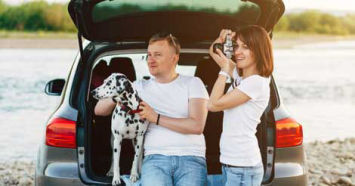
You get ready to leave for work each day and see the sad look in your pet’s eyes as you reach for the doorknob – you cannot fathom the idea of leaving them behind when you go on a trip. Whether you are flying or driving you’ll want to make sure you’re traveling companion is comfortable and safe. Here are some cat and dog-friendly travel tips for when you decide to pack up your furry family member:
1. Decide on Transportation: Flying vs Driving
One of the first things you should do is decide how you will be traveling.
If You're Driving
If your pet is used to car rides, you likely won’t have any issues. However, if your pet isn’t used to rides, you should start by taking them on short car rides around the block and then lengthen the ride a bit to get them used to the car. If your pet isn’t used to the car, don’t just assume they will be fine. Dogs, and even cats, can experience a great deal of anxiety about something new like traveling.
If You're Flying
If you decide to fly with your dog, here are some tips on how to make the trip as smooth as possible:
attempt to fly direct, non-stop
buy a carrier with identification tags
eat, drink, poop, then fly
NO tranquilizers or sedatives,
Most importantly, check with your specific airline regarding rules and regulations on how to travel with pets. Many airlines have requirements on where dogs are kept and what destinations they can fly to.
2. Keeping Them Safe and Secure
As you’re making a list of everything you need for your trip, add a well-ventilated pet carrier or crate. Whichever type you choose, make sure your pet will be able to move around, stand, and sit in it. If you can’t find a crate or carrier to meet your needs, a pet safety belt is the next best option.
3. Bring Something Familiar
Does your pet have a favorite blanket, toy, or bed? It’s ideal to bring cat and dog travel items with you as they can ease some anxiety and provide a sense of familiarity.
4. A Quick Vet Check Can’t Hurt
Make sure your pet is physically healthy and ready for the trip with a quick check-up at the vet. Talk the trip over with your veterinarian to ensure your pet has the right temperament and health status to take on a lengthy trip and new surroundings.
5. Think About Microchipping
Losing your pet would be a devastating experience. Thankfully, technology has come a long way. At your pre-trip check-up, talk to your vet about microchipping your pet. A microchip is about the size of a piece of rice and injected under the skin. The microchip comes with a registration number that can be read by using a scanning tool, which will then link to your information.
If your pet is already microchipped, make sure all of your information is current. Check their tags to make sure everything is up-to-date as well.
6. Stop for Breaks
If your pet is used to a normal potty and feeding routine, make sure to schedule your trip in such a way that will allow for the same breaks. It’s not ideal to feed your pet in a moving vehicle, so make it a point to stop during regular feeding times.
Before you venture out on your road trip, check online and see which rest stops along the way have dog walking areas. This will give your pup a break to stretch his legs.
7. Make Sure Your Pet Keeps Their Head Inside
While it’s cute to see your dog stick their head out the car window and take in all the fresh air, it’s not safe. Oncoming traffic or flying objects could injure them. It’s best for your dog to sit in a pet seat belt or a crate.